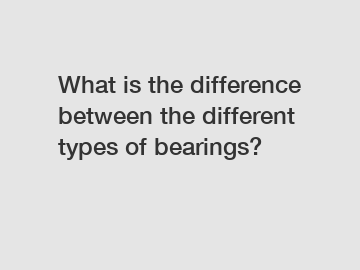What is the difference between the different types of bearings?
Bearings play a crucial role in countless mechanical applications, providing smooth movement and reducing friction between moving parts. While the concept of a bearing is relatively simple, there exist various types of bearings, each tailored for specific applications. In this article, we will delve into the key differences between different types of bearings, shedding light on their unique characteristics and applications.
Rolling Bearings:
Rolling bearings, also known as anti-friction bearings, are widely used in numerous mechanical systems. These bearings comprise two main components: an inner and an outer race, with rolling elements such as balls or rollers in between. The rolling element reduces friction by rolling between the races. Rolling bearings provide excellent load-carrying capability and durability, making them ideal for applications with high radial or axial loads, such as automotive and industrial equipment.

a) Ball Bearings: .
Ball bearings are one of the most common types of rolling bearings. They consist of spherical rolling elements, usually balls, which facilitate smooth rotation under radial or axial loads. Due to their low friction characteristics, ball bearings are suitable for applications that require high speed, low torque, and precise rotation, like electric motors and conveyor systems.
b) Roller Bearings:
Unlike ball bearings, roller bearings employ cylindrical or tapered rolling elements instead of spherical balls. These bearings distribute weight over a larger surface area, enabling them to handle heavier loads and withstand radial/axial forces. Roller bearings are commonly used in applications such as heavy machinery, automobiles, and construction equipment.
Plain Bearings:
Plain bearings, also known as bushings or sleeve bearings, differ from rolling bearings in their design and functionality. Instead of rolling elements, plain bearings employ a sliding mechanism between the shaft and the bearing surface. This sliding action generates more friction but allows for continuous contact between the two surfaces, ensuring enhanced stability and load capacity.
a) Journal Bearings:
Journal bearings provide support to rotating shafts by employing a fluid film between the shaft and the bearing surface. The fluid film enables smooth movement by separating and lubricating the two surfaces. Journal bearings are often utilized in large and high-speed machinery, including turbines and engines.
b) Thrust Bearings:
Thrust bearings are designed to withstand axial loads exerted parallel to the bearing's axis. They are commonly found in applications requiring precise axial positioning, such as automotive transmissions and household appliances.
Conclusion:
Understanding the differences between various types of bearings is essential for selecting the most appropriate option for a specific application. Rolling bearings, including ball and roller bearings, excel in high-speed and heavy-load applications, while plain bearings, such as journal and thrust bearings, offer stability and continuous contact for smoother operation. Regardless of the type, bearings are essential for reducing friction and promoting efficient movement in countless mechanical systems.
For further information or assistance in choosing the right bearings for your needs, please do not hesitate to contact us.
Are you interested in learning more about How to Choose the Right Roller Bearings for Your Needs, Chinese High Quality Bearing, Spherical Thrust Roller Bearing Manufacturer? Contact us today to secure an expert consultation!
216
0
0

Comments
All Comments (0)